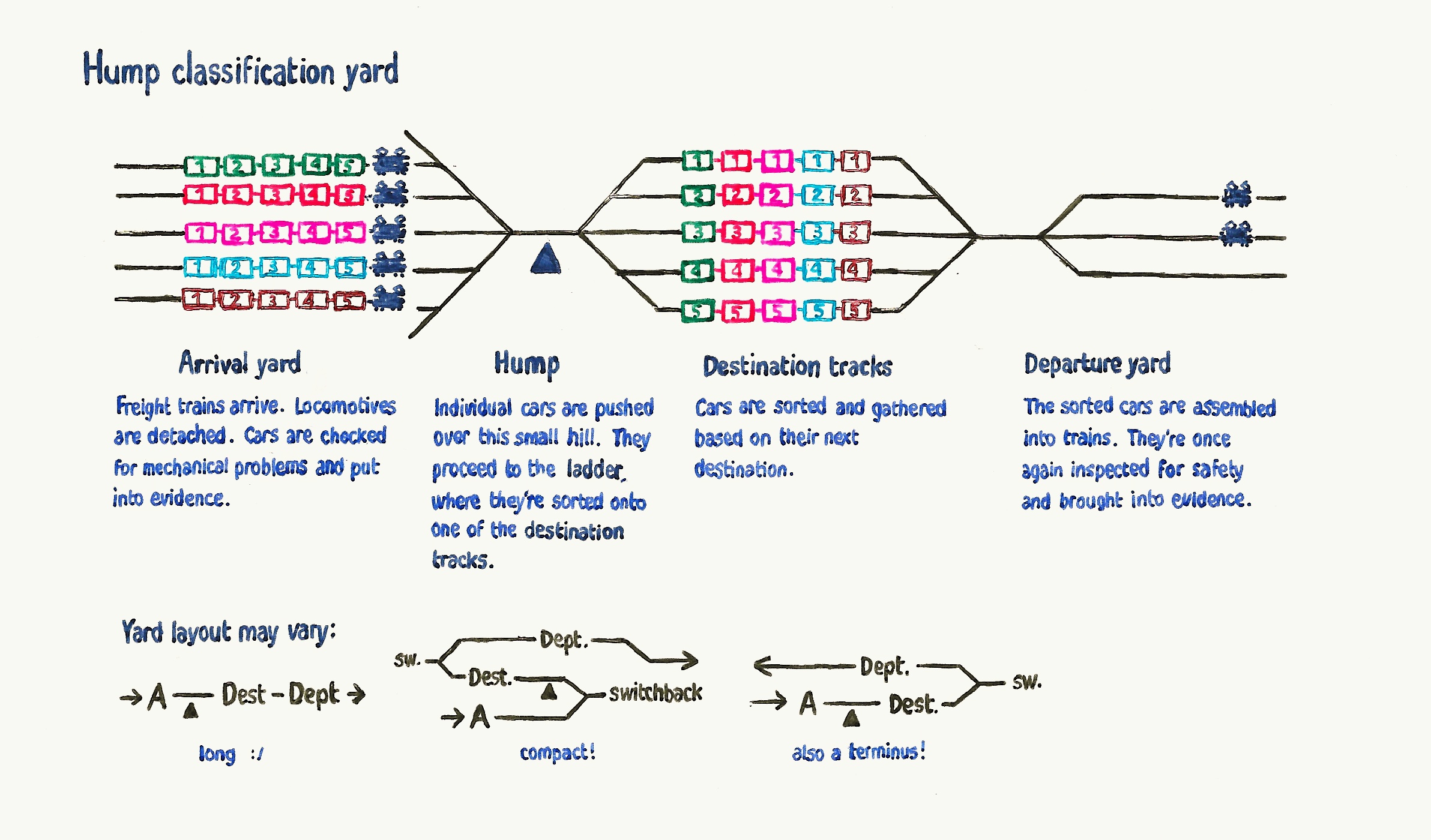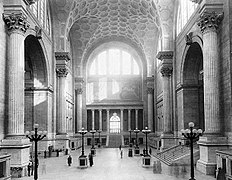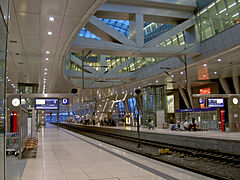Help:Making realistic railways/3: Difference between revisions
(Created page with "{| width="100%" style="font-size:110%" |- | <span style="white-space:nowrap;display:inline-block;line-height:1.2;background:#e1045c;border-radius:15px;padding:3px"> He...") |
mNo edit summary |
||
| Line 109: | Line 109: | ||
| <span style="white-space:nowrap;display:inline-block;float:right;background:#e1045c;line-height:1.2;border-radius:15px;padding:3px"> [[Help:Making realistic railways/4|<span style="color:white">'''>'''</span>]] </span> | | <span style="white-space:nowrap;display:inline-block;float:right;background:#e1045c;line-height:1.2;border-radius:15px;padding:3px"> [[Help:Making realistic railways/4|<span style="color:white">'''>'''</span>]] </span> | ||
|} | |} | ||
[[Category:Tutorials]] | |||
Revision as of 23:05, 15 January 2022
| < | > |
This is part three of the tutorial on making realistic railways. The previous chapters covered the railway history and use and landscape. This topic will be railway stations: everything about them, from layout to function to drawing tips. Let's get the party started!
Types of stations by layout
These are the basic types of train stations based on track layout. The first en-route one is by far the most common, used everywhere. Then there is the terminus, which can be either way be a large station in a city and a start point for trains serving many destinations, or the final station on a branch line. A switchback is used in difficult terrain, where a curve would be too expensive or is impossible to build. It obviously has its ups and downs, the biggest advantage is that switchbacks are cheap to build, the biggest disadvantage is that trains going through them have to be equipped with engines on both sides and the ride takes a longer time. The turnout station is more practical, these are mostly stations that became junctions later after they started operating, but the new lines couldn't lead directly to the old station due to terrain (many of them are in the Alps.)
The last two are a bit special. The multi-level station is used at places where two lines cross each other and passengers potentially want to transfer to one another, but a junction would be an unnecessary detour. Occasionally, even the classical en-route station has more floors, for example the Berlin Main Station (actually, a lot of these are in Germany.) And finally, the break of gauge station is where railways of two different gauges meet, but more about that next time.
There are also combinations of these types. Main line stations often have some dead-end platforms for terminating suburban or local trains.
Passenger stations
Different stations in different locations
There are two main types of stations based on their size: stops (also called halts) and, well... stations. The difference between these two is that stops are usually just a platform next to the tracks, they don't have station buildings, a ticket office or other facilities. A station meanwhile usually has multiple tracks and platforms, allows trains to pass each other, and has a building with a waiting room, toilets and a ticket office. It's then rather obvious that stations are found in towns and at junctions (where multiple lines meet), and stops in the countryside or city suburbs. Passenger stations also often have a cargo part with a goods shed, a loading area and some freight train tracks (see Cargo stations.)
Here are a few things to consider when deciding. Stops can be built basically wherever you like, but stations should be leveled (i.e. the terrain has to be completely flat) and tend to be on the straight stretches of the railroad - so the station is organized and also safer. There obviously are exceptions, but these occur mostly in difficult terrain, at branch lines and when there's not enough space.
Another thing to keep in mind is how far apart from each other the stations are. This depends on how densely populated your country is, but there is a threshold you shouldn't cross and that's 800 meters minimum distance. Obviously there are exceptions to this rule too, especially in cities or near places of interest, trains can stop more frequently, but that shouldn't be the entire line. Central Europe is densely populated and stations and stops are usually 2 - 5 kilometers apart from each other here. Meanwhile for example in the USA, rail transport is primarily used for cargo and so there are cities with tens of thousands of inhabitants without passenger stations.
Needless to say, the size of the station depends on how frequented it is. With local stops in the countryside, you're often left with a dirt patch next to the tracks and a rusty metal shelter at best. At commuter rails, the platforms are going to be wheelchair-accessible with a roof and some ticket vending machines, benches and advertisement boards. While stations in cities are going to be extensive, crowded and busy, local stations in smaller towns are often cozy, feature a tourist information board and are decorated with flower pots and even kitsch miniature castles made of gypsum.
Train stations in cities are often situated surprisingly close to the old town/city center. That's because in the late 19th century, when most railways were built, cities were much smaller than today. It was also the time fortification walls were torn down, so the new stations often arose where they used to stand. It's also worth noting that the 19th century was the blooming era of capitalism, and railways were no exception: different railway companies built separate stations in the city. This often caused problems later in the 20th century, when most lines were either way bought by the state or closed down, and passenger transport began to prevail - people would often have to travel to the other side of the city to transfer to another train. Vienna is a perfect example of this, as well as other European cities.
Platforms
Every passenger station has a place where people board or get off the train. How that place looks also depends on the size and usage of the station. A stop somewhere in the countryside might just have a gravel mound next to the track, but most stations have paved platforms.
Mind the gap, but also the length of the platform. Depending on how long the trains are, platforms can span anywhere from 75 meters (that's the Czech minimum for small stops in the countryside) to 200 meters (village stations) to 400 meters or longer (large stations in the city.) If there is a lot of space in one direction but not in the other, or additional space for manipulation with cars is required, platforms can be almost twice as long, but that's rather unusual.
The same goes for width. The platforms should be wide enough to allow for free and safe movement of passengers. In village stations, it's enough to draw them as a line. Platforms on main lines are (depending on layout) 6 and more meters wide. The ones in central stations in cities have 8–14 meters. Be realistic: 20 meters is too much already, that's the width of an average apartment complex.
An easy way to draw them in JOSM is to create a parallel line (Shift+P) 1.5 meters from the line tagged as railway=rail. Tag this new line with railway=platform. In case you're drawing an area, you have to set the tag area=yes as well, since the platform acts like a path by default.
Platforms are connected directly by a walkway crossing the tracks or via an overpass or an underpass. The last two options are used more often on main lines, where trains pass through stations at high speeds and people could easily get hit by one. Sometimes the pass continues beyond the station and leads directly to a public transport terminal, a residential neighborhood, a park etc.
Tag the tracks next to the platforms with service=siding. Make sure they're adequately spaced - 4.5 meters, as mentioned previously, is the minimum.
To spice it up a bit, you can decorate your platforms with benches: amenity=bench and water fountains: amenity=drinking_water.
Buildings and facilities
From a passenger's point of view, the most important part of a station is the head house (or simply the "station building" in some forms of English.) This building usually features a ticket office, a restroom and an information board, sometimes payphones and a mailbox. At larger stations, there are shops and even a station restaurant or café. In large cities, shopping malls and hotels are often found nearby. These buildings are tagged with building=train_station.
Most train stations have good outside connections. Once again based on how many passengers there are, or how convenient is the location, there can be a bus stop or an entire bus terminal. In cities you'd want to think about taxi lanes and subway stations. Bicycle parking is frequently found at stations, in tourist locations bicycle rental too. Many stations can be reached by a bicycle path as well. Last but not least, some passengers drive to the train by car, so there should be enough parking space as well.
There's however much more to a station that just a head house. Don't forget the signal boxes or the dispatcher office. While the head house is usually the largest and most prominent, it is accompanied by countless smaller side pavilions and sheds.
Junctions
Junctions were introduced in the last episode. Junctions at railway stations are sometimes quite complicated and consist of tens, even hundreds of switches. It's important to stay true to size and be modest, try not to make a mess. With a large amount of switches, there should always be a signal box. That's a tall building with a view of the entire junction, from which the individual switches and signals in the station are controlled.
As always, the best advice is to look at stations in the real world. If you live near one, make a trip there, study it. Satellite images of stations are particularly helpful, especially with understanding how switches work and how to lay them out in a realistic way.
Cargo stations
Goods stations are a bit more complex, but don't worry. These were introduced in part 1, where the journey of goods were shipped by train. Even freight stations vary in size. This tutorial omits the smallest types, because most goods are shipped by trucks nowadays in denser environments. During modernization works, freight tracks and warehouses at smaller stations are often dismantled.
Let's jump right ahead to medium-sized cargo stations. These are usually located at main lines near passenger stations in larger towns or where multiple lines meet. Because these usually just points where main line freight trains pick up wagons to transport to their next destination, or where they leave them to be transported to factories, you're going to want to have enough manipulation space. There should be some tracks where the loaded cars can wait for their freight train, where the empty ones stand and where the freight trains pick up these wagons. Some additional tracks at the ends of the station, where a switcher engine (in British English shunter) collects and organizes wagons and then pushes them to the track where the freight train waits.
If you want to make things a bit vintage, you can also place a ramp or a loading platform at your station, so that goods delivered by trucks to station can be loaded onto the wagons more easily. Obviously you don't need one to load wagons, but it saves some manual labor. There should also be some warehouses for goods waiting to be loaded. You can also draw specialized facilities based on the prevalent type of goods at the station. For example, if there are coal mines around, there can be transporters sorting the coal and pouring it right onto the wagons, which saves another great amount of work. If you're drawing a station near oil fields, it's probably going to have oil storage containers.
Another common type is the container station where containers can be handled. This is perhaps the most frequently used type nowadays. Containers are lifted off wagons and later loaded on container trucks. This type of station doesn't actually take up too much space, you're just going to need a few tracks for the incoming trains, some machinery carrying the containers around, some waiting area and truck platforms.
Classification yard basics
On long distances, cargo is shipped through multiple stations. The largest transport hubs usually dispose with a classification yard (marshalling yard in Br. English), which is an advanced structure used for fast and efficient sorting of wagons. Because they're quite tricky to draw, this hand-drawn illustration should help you understand how the yard works, and from there it will be easier to draw one. This illustration describes a hump yard, as it is the most common type. In a hump yard, cars are pushed over a small hill and then roll down onto one of the destination tracks just by the force of gravity, which is convenient.
Hump yards can be really large, with the largest counting over 70 parallel destination tracks. Be realistic when it comes to size. Tag the tracks with service=yard.
Architecture
This is more of a side note, but many railroad companies had their signature architecture style and stock buildings that would be replicated at every station. This is no longer true as many railways are now state-owned (at least in Europe) and fewer new ones are built. However, many valuable modern architectural landmarks are train stations. Below is a gallery of interesting railway architecture.
Weekly exercise
Perhaps unsurprisingly,
- Draw a train station. It can be small or big, passenger or freight, doesn't matter. If you're unsure about your skills, practice by drawing in the blue countries - they have a lot of railways that yearn for more detail or a complete revision.
- Study the railway stations near where you live. Try to find inspiration. Aerial view can be of great service.
| < | > |




















